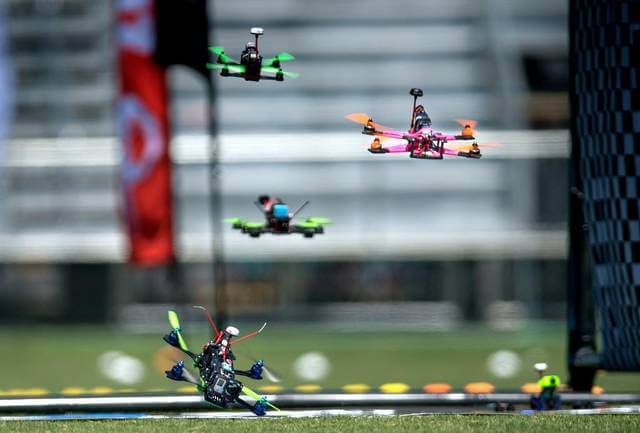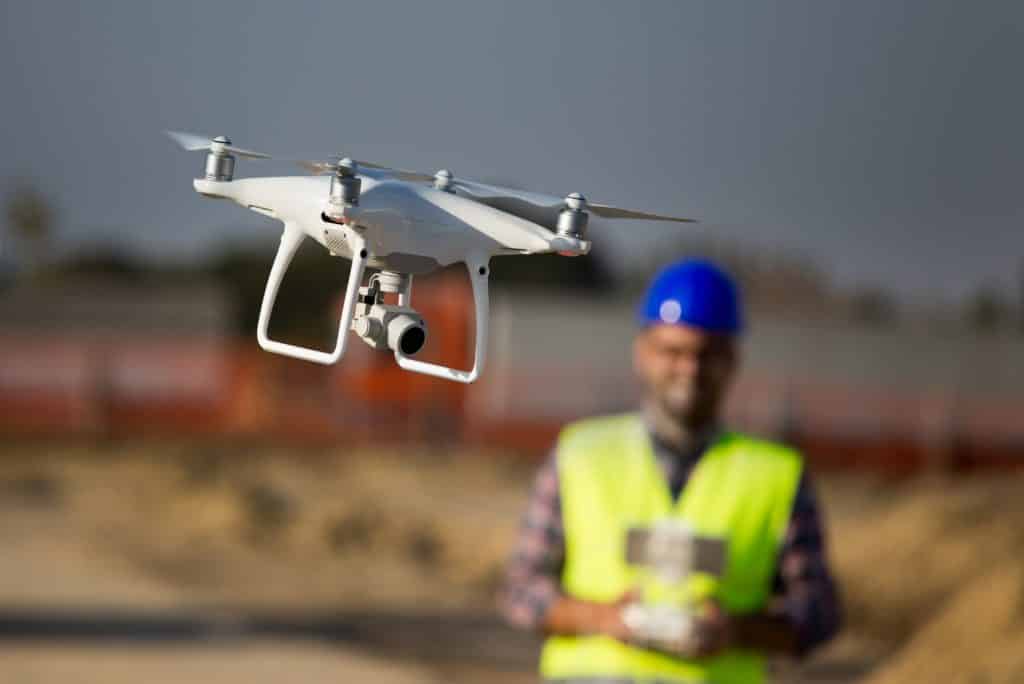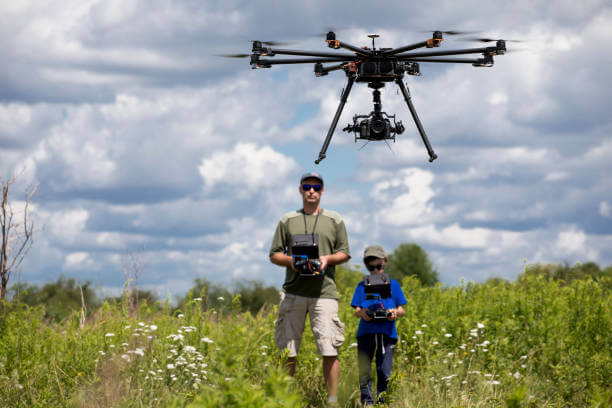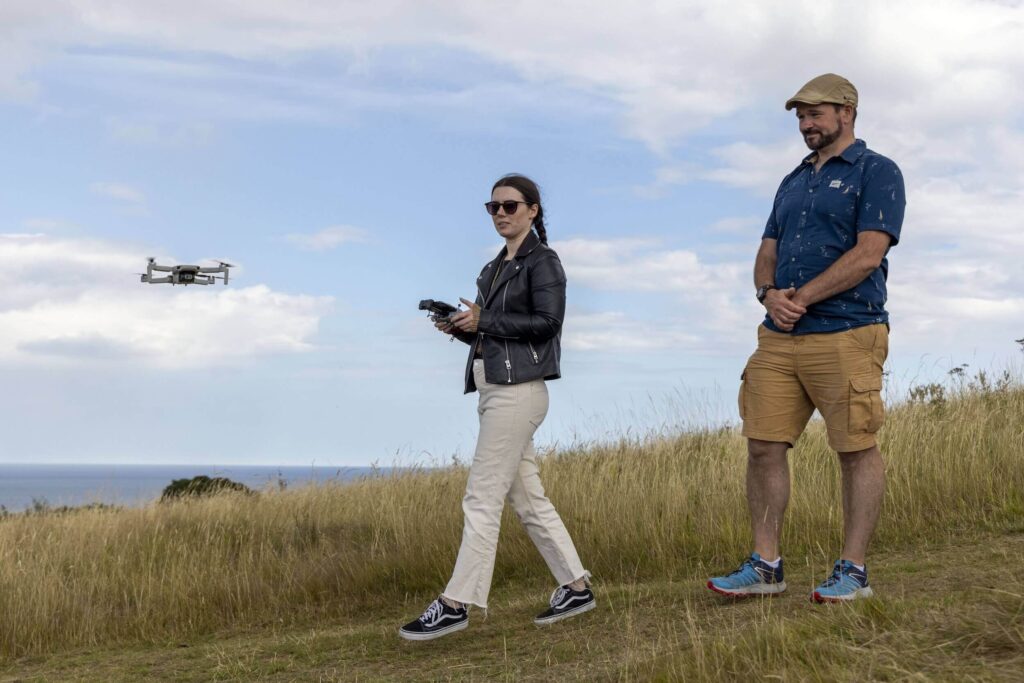For filming and racing, the drone is turning out to be progressively important.
Drone racing was first held professionally in 2014.
Drone racing is a competitive sport that includes flying drones.
Drone pilots wear goggles or head-mounted displays associated with the drone’s camera.
In the air, the racing drone should be quick, steady, and agile, with the ability to make smooth flips and rolls.
The control range ought to be satisfactory for a drone racer, and the flying time ought to be adequate to own the race.
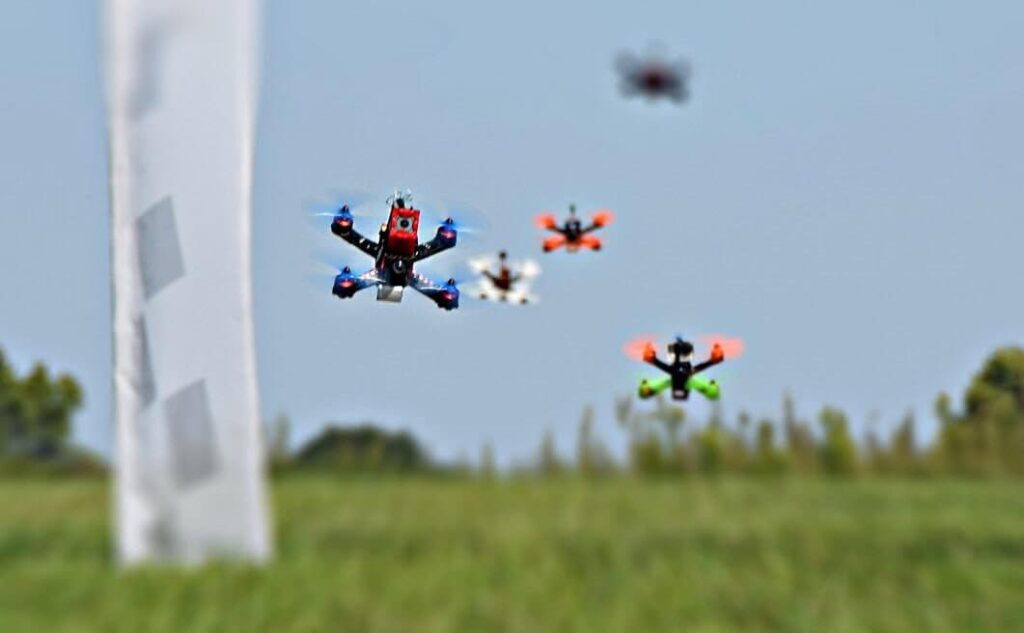
Top 5 Best Drones for Racing in 2024 USA Reviews
1. DJI FPV Combo: Best racing drone under 1000$
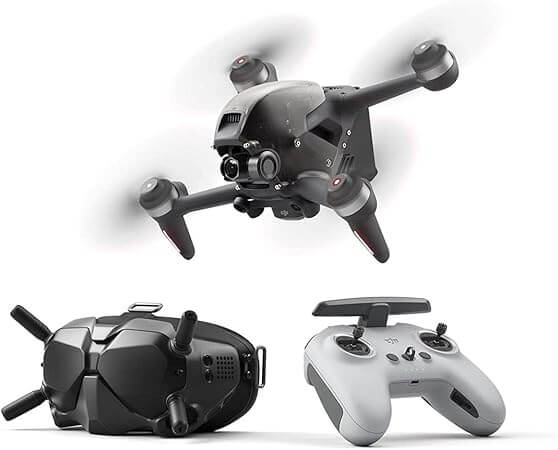
Pros
- Brand: DJI
- Model Name: DJI FPV
- 1080p Video Transmission
- Focus Track Subject Tracking Modes
- Return to Home & Precision Landing
- Easy to Operate
- HDR Video, Images & Panoramas
- Remote Controller & Fly More Accessories
- Color: Gray
- Control Type: Remote Control
- Up to 34 Minutes of Flight Time
- Video Capture Resolution: 4K HD
- 240 fps Slow Motion at 1080p
- 8K Hyperlapse Time-Lapse Video
- Up to 4K60p Video & 48MP Images
- APAS 3.0 Obstacle Avoidance
Cons
- 87mph top speed raises safety concerns
What is the most recent athletic craze?
Drone racing is a prominent sport in the United States.
Drone racing is a well-known sport for technology nerds and racers that consolidates computer-generated reality technology with video game rivalry.
Pilots had the option to capture and transfer races utilizing drones furnished with minuscule cameras.
This carefree racing with my kin has made me an insane oddity.
In any case, with the tomfoolery, budget is additionally fundamental.
Remembering this, I bought another drone named DJI FPV Combo.
It is the most fantastic drone for having amazing race time and lushes.
I traveled to the field with my companions and kin for a night out.
We’ve finished a race together.
Racing with this drone was an exhilarating encounter.
It is the best racing drone for under 1000$.
Features:
The Future of FPV Racing:
The DJI Advanced FPV System supports DJI HD Low Latency FPV Transmission.
This recently made technology is planned to make your FPV experience shockingly better.
Pilots can race more smoothly with a postponement of less than 28 milliseconds and a completely clear vision.
Intelligent Drone:
The DJI Computerized FPV System is a completely integrated video transmission system that incorporates great parts and fundamental frills, setting aside pilots’ time and cash by wiping out the need to independently buy every module.
The implicit recipient and simple flight controller system make gathering a breeze.
Every part has been coded to begin working when it is turned on, recalling introductory associations with different parts and eliminating the need to pair modules or adjust settings before every usage.
Why is this drone the best?
I like this drone the most because it has a fantastic battery life of 34 minutes.
It flew this drone during our visit to the open country.
Because of its timing, it remained for such a long time overhead for racing.
My drone went on top because of additional features and long battery time.
Conclusion:
The energy of vivid flying is conveyed with the DJI FPV Goggles V2.
Real-time HD video provides an ultra-smooth vision of your flight.
For the cash, it’s the most fragile beginning drone.
It was fantastic for making videos and photographs during racing.
It never lets me down.
It is the best racing drone for under 1000$.
2. EMAX Tinyhawk 2 FPV drone: Best drone for indoor racing
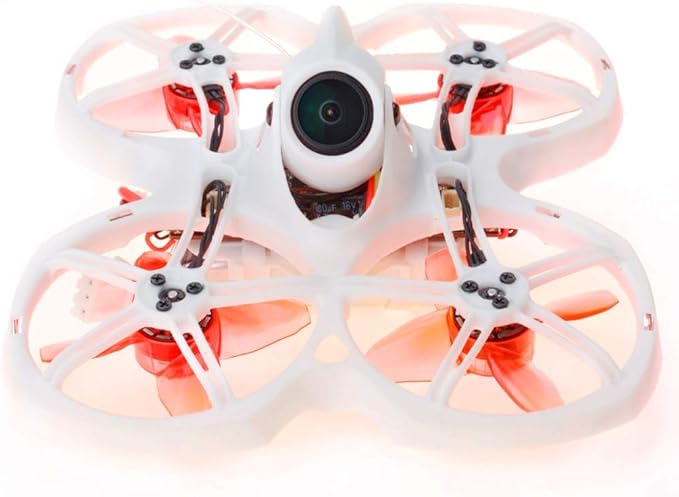
Pros
- Brand: EMAX
- Control Type: Remote Control
- Material: PP
- Are Batteries Included: Yes
- Item Weight: 31.2 Grams
- Battery Cell Composition: Lithium Polymer
- Wheelbase: 75mm
- Dry Weight: 31.2g
- All Up Weight: 43.5g with 1x 450mAh
Cons
- Very Light Frame
Whether you’re a first-time drone pilot or have a couple of under your belt, finding a reasonable indoor racing drone at a sensible cost can challenge.
I’ve found the ideal drone for my racing named EMAX Tinyhawk 2.
The EMAX Tinyhawk 2 is an indoor FPV camera drone with a conservative structure and remarkable flight execution.
I believed that a drone should do indoor racing with my kin.
I try not to play with them outside as they are youthful.
They had their mini-drones however frequently preferred to ride with this drone.
It worked splendidly for directing races.
It’s a fantastic quadcopter drone that costs a sensible measure of cash.
I’d rate myself as a fair flyer.
This Tinyhawk 2 Pack is fantastic, and I’ve had loads of fun with it! It accompanies a controller and eyewear for the headset.
You’re prepared to take off after you’ve switched everything around.
It is the best drone for indoor racing.
Features:
Fantastic Drone:
The Tinyhawk 2 is a development to the first Minuscule Falcon, with improvements to stability, camera quality, speed, and generally flight insight for drone pilots.
The Runcam Nano 2 FPV camera used in this model is the drone’s most extraordinary feature.
I can shoot stunning films in encased and open locations and have a quick, exquisite drone flying experience while racing.
E6 Transmitter and FPV Goggles:
The E6 transmitter controller is an unquestionably all-around designed, smooth, and agreeable distance that permits me to move, power openly, and control the drone with amazing stability in any place I need.
Why is this drone the best?
The Runcam Nano 2 FPV camera records are seen in this version.
This camera gets flawless optics and takes fresh and stunning visuals utilizing a bigger number of channels and power than the first video transmitter.
It has 25mW until it is equipped, however it very well might be helped to 100/200mW for enhanced range and article infiltration for precious stone quality videography.
Conclusion:
Generally speaking, the EMAX Tinyhawk 2 is a fantastic drone at the cost of the RTF pack, in my view.
It’s steady and high-quality, and it’ll work well whether you’re a fledgling or a carefully prepared drone pilot.
With a sensible cost range, it is best to do racing indoors, and it has great obstacle avoidance.
It is the best drone for indoor racing.
3. Holy Stone HS200 FPV: Best drone for beginners racing
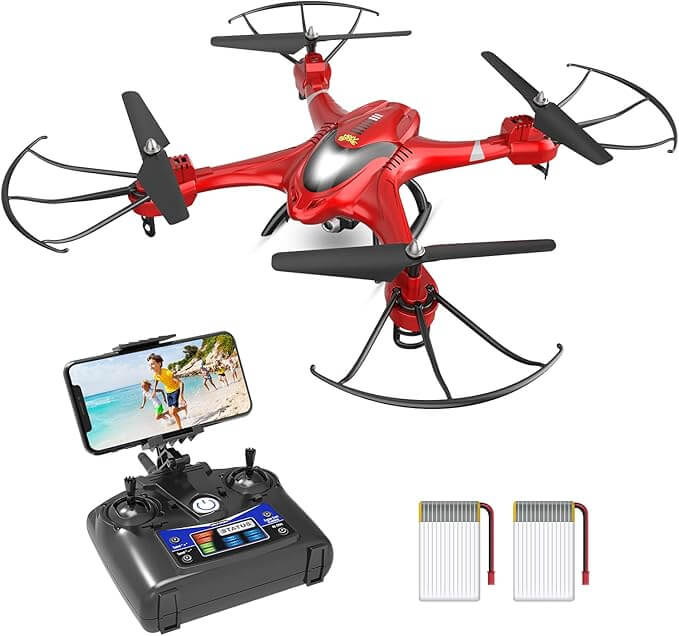
Pros
- Brand: Holy Stone
- Control Type:App Control
- Material: Plastic
- Video Capture Resolution: HD 720p
- Are Batteries Included: Yes
- Wireless Communication Technology: Wi-Fi
- Video Output Resolution: 1280×720 pixels
- Battery Cell Composition: Polymer
- 120° Fov 720p Hd Wi-Fi Modular Camera
- 2 Batteries (18 Mins)
- Voice/App Control
- 6-Axis Gyro
- Waypoints Fly
- Hand Gesture
- Low Battery Power Alarm
- 2.4ghz Remote Controller
Cons
- Mediocre flight times
- Cannot fly indoors
My dad gave me my most memorable drone, and I was excited to open it.
For my YouTube channel, he sent me a Holy Stone HS200 FPV.
I once let him know I needed a drone for aerial photography and filming.
I’ve been involving this drone for a month at this point.
My companion welcomed me to contend with him in a rivalry to see whose drone was the quickest and best at shooting photographs of fields.
It was a splendid idea.
It was not excessively costly for my initial beginning, so I was immediately ready for the race.
The Holy Stone HS200 is a beginner-accommodating drone that is not difficult to fly, has numerous fantastic features, and expenses around $100.
It comes in two tones: high contrast.
It is the best drone for beginner’s racing.
Features:
Height Hold:
The Height Hold choice makes controlling the drone considerably more available.
Improve the flight’s stability and smoothness.
This feature madeloseoose my racing time.
I’m a professional drone more shot here and there becoming a youngster with my companions and leading races.
Headless Mode:
Another beginner-accommodating feature, the headless mode, wipes out the requirement for the pilot to stress over the drone’s course during a flight.
Without headless mode, it’s difficult to recognize a drone’s head and tail, making it hard to foresee how the drone will fly.
It tends to be perilous, particularly for fledglings.
Why is this drone the best?
The drone is small, estimating 12.6 x 12.6 x 2.6 inches, and it features propeller covers to minimize any harm that might happen assuming it crashes, which is highly probable assuming you are a fledgling.
It accompanies a pair of landing legs to help me in satisfactorily landing your drone, and because the camera is mounted on the drone’s midsection, the landing legs will likewise protect the camera from hurt.
The HS200 additionally incorporates a few fantastic Drove lights that simplify it to fly at night and provide a great visual impact.
Conclusion:
The Holy Stone HS200 is an incredible pick on the off chance that you’re searching for a beginner-accommodating drone.
It is best for racing moreover.
It’s simple to fly, has numerous brilliant features, and is sufficiently extreme to endure a couple of knocks.
It is the best drone for beginner’s racing.
4. iFlight Nazgul5 V2: Best drone for racing in low light
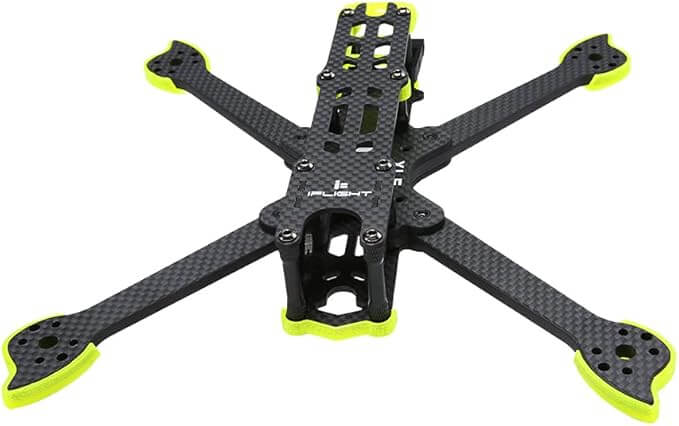
Pros
- Brand: IFlight
- Material: Tbs
- Are Batteries Included: No
- Battery Capacity: 1300 Milliamp Hours
- Battery Cell Composition: Lithium Polymer
- 5mm arm design for more durability
- Easy-Swap arms
- LED illuminated Logo
- XING-E 2207 motors and Nazgul 5inch props
- 5″ version also fits 5.1″ style propellers
- Popular True-X configuration
- TPU crash-guards
- Thick carbon fiber arms with corner protection
- GoPro mount
- Excitingly fast
Cons
- None
Today, I will educate my buddies regarding my #1 drone race episode.
We were all lying near the ocean in Hawai’i towards morning, and the cool air loosened up our viewpoints and resuscitated our spirits.
Out of nowhere, one of my companions took out his camera to capture the sun’s low light.
He proceeded with that nobody could win before him since nobody could play a drone for himself and shade the dull daylight.
I tested him by letting him know that I might abandon him.
I in a split second took out my iFlight Nazgul5 V2 Drone and moved him to a race.
We took pictures, and I won because of my #1 drone in no time flat.
Regardless of the little light, it was the most incredible choice.
For my purposes, it is the best drone for racing in low light.
Features:
Amazing Camera:
The Caddx Ratel FPV camera that accompanies the quad has a 2.1mm focal point, a 1/1.8″ sensor, and a resolution of 1200 TVL.
The camera accompanies a little joystick that is useful for changing the camera’s settings.
However, the connector is challenging to reach, so you’ll have to eliminate the top plate to connect it.
The image quality is astounding, and it operates splendidly in low light.
It is my favorite camera for any FPV quad.
Solid Casing:
The iFlight Cidora 5″ casing is incorporated with the quad.
It’s a 3K carbon fiber outline with a 215mm wheelbase.
It works with miniature and little cameras and 30.5×30.5mm and 20x20mm stacks.
Arms are flexible according to necessities.
Why is this drone the best?
Nothing vibrates or twists in the carbon fiber outline, which feels like one Goliath piece.
It’s a fantastic improvement.
It’s associated with a 5.8GHz receiving wire that can send simple and computerized signals, allowing it to travel enormous distances, likewise in areas where hindrances hamper signal transmission while racing.
With 5mm thick carbon arms, even a quick collision will be fierce to harm this drone, yet if you need to try it out, iFlight offers the machine in both (quick) 4S and (shrieking) 6S models.
It’s even equipped for staying aware of a fixed wing.
Because of its solid body, I had never dealt with any problems while racing.
Conclusion:
It is a splendid drone in all viewpoints with a solid body.
I have used it for some reasons, similar to my loved ones’ videography.
Also, click aerial and surveying shots.
Other than this, it is the best drone for racing on getaways.
iFlight Nazgul5 V2 is the best drone for racing in low light.
5. Walkera F210 Professional Racer: Best drone for experienced racing
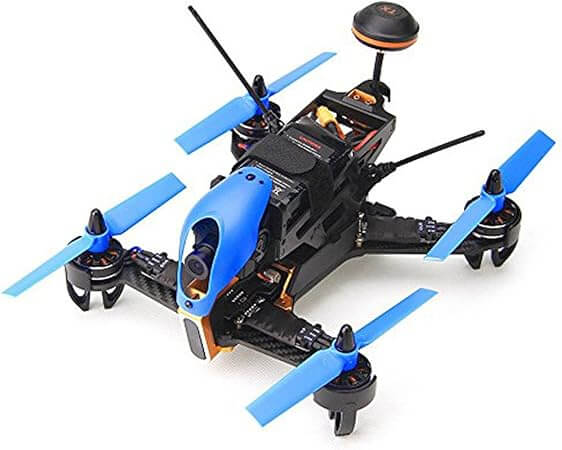
Pros
- Brand: Walkera
- Control Type: Remote Control
- Material: Carbon Fiber
- Video Capture Resolution: SD VGA 480p
- Are Batteries Included: No
- Battery Capacity: 1300 Milliamp Hours
- Video Output Resolution: 854×480 Pixels
- Remote Control Included? Yes
- Age Range (Description): 168 months
- Battery Cell Composition: Lithium Polymer
- Weight: 370g inc battery
- Dimensions: 182 x 182 x 103mm
- Diagonal size: 210mm
- Controller: 5.8GHz
- Video resolution: NTSC
- Camera resolution: –
- Battery life: 12 mins
- Max range: 800m
- Max speed: 100mph (160kph)
Cons
- Poor Battery Life
As a professional drone racer, I wanted a high-quality drone for my flying requirements.
In this period, veritable drone races are coordinated to test a pilot’s ability.
For very nearly 10 years, I have worked as a professional drone pilot.
For my races, my #1 drone is the Walkera F210 Professional Racer.
It has a fantastic structure and provides me with unexpected impacts.
I had never lost a race with this drone.
It improved my ability to fly and take photographs of things.
It is the best drone for experienced racing.
Features:
Ideal for Night:
The camera contains 1,000,000 pixels, a high-definition night vision focal point, and high-execution sensors, and its photosensitive sensors can automatically conform to the brilliance of the light.
SP racing F3 flight control:
F210 is protected and against crashes, and it’s simple to assemble and dismantle.
The players like me change the speed deftly as per requests.
Because of the freshest F3 flying system, professional speed controller, and 5.8G picture transmission, had been a blessing for its users.
Why is this drone the best?
The F210’s carbon fiber racer body and a protective cover engine design make it solid and hostile to crash, with a flying velocity identical to F1 racing.
The one-of-a-kind DEVO 7 far-off controller features a delicate joystick and buttons for improved control association.
It’s not difficult to operate because of the ergonomic form shape.
The camera can offer an exhaustive and detailed view, even on shady days or at night, with the movable point, high-definition night vision camera, and real-time image transmission, allowing players to unreservedly fly the racer.
Conclusion:
It is quick, steady, and agile in the air, with the ability to do flips and rolls effortlessly.
For a drone racer, the control range is above and beyond, and the flight time is adequate to help you through the race.
It is the best drone for experienced racing.
Buying Guide: Best Drones for Racing
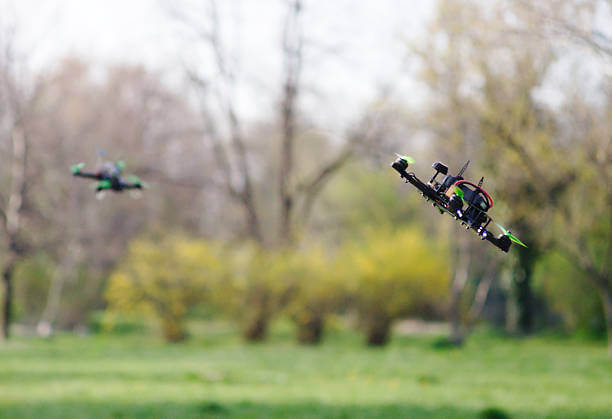
1. Understanding Racing Drones
Before diving into the best drones for racing, it’s crucial to understand what racing drones are. Unlike camera drones, racing drones are built for speed, agility, and performance. They are designed to navigate tight courses at high speeds, often exceeding 100 mph. Racing drones usually have a First-Person View (FPV) system, allowing the pilot to experience the race as if they were in the cockpit. This guide will help you choose the best racing drone based on your needs and skill level.
2. Key Features to Consider
When selecting a racing drone, several key features should guide your decision:
- Speed and Agility: The drone’s speed is paramount in racing. Look for drones that can reach high speeds quickly, and consider how agile they are in maneuvering through obstacles.
- Durability: Racing drones are prone to crashes, especially for beginners. A durable frame made of carbon fiber or another strong material can help your drone withstand impacts.
- Battery Life: Racing drones are power-hungry, and their batteries typically last only a few minutes per flight. Choose a drone with a battery life that suits your racing needs, and consider purchasing extra batteries.
- FPV System: An FPV system is essential for racing. Look for drones with high-quality cameras and low-latency video transmission systems to ensure you can react quickly to the environment.
- Ease of Repair: Crashes are inevitable in drone racing, so having a drone that is easy to repair with readily available parts is important. Modular designs make repairs quicker and less costly.
- Flight Controller and Software: The flight controller is the brain of your drone. Advanced controllers offer better stability and more customization options. Software like Betaflight allows you to tweak your drone’s settings for optimal performance.
3. Types of Racing Drones
Racing drones come in different types, each suited for various racing styles and skill levels:
- Ready-to-Fly (RTF): These drones come fully assembled and are perfect for beginners who want to start racing immediately. However, they may offer less customization.
- Bind-and-Fly (BNF): These drones require you to provide your own transmitter. BNF drones are a good option for pilots who already own compatible equipment.
- Almost Ready-to-Fly (ARF): ARF drones are partially assembled, requiring you to complete the build. They offer the best customization but are suited for more experienced pilots.
- Custom Builds: For those who want complete control over their drone’s performance, building a custom drone from scratch is the way to go. This option is for advanced pilots who understand drone components and how to optimize them for racing.
4. Budget Considerations
Racing drones can vary significantly in price. Beginners may want to start with a more affordable RTF model to get a feel for drone racing without a significant investment. As your skills improve, you can invest in higher-end models or even consider building your own custom drone. Keep in mind that you’ll also need to budget for extra batteries, replacement parts, and possibly a better FPV system as you advance.
5. Legal and Safety Considerations
Before purchasing a racing drone, it’s important to be aware of the legal and safety aspects of drone racing:
- Regulations: Make sure to check local regulations regarding drone usage. Some areas require registration of drones over a certain weight, and there may be restrictions on where you can fly.
- Safety Gear: When racing, especially in organized events, wearing safety gear like goggles and helmets is recommended to protect yourself from potential accidents.
- Insurance: Consider getting insurance for your drone, especially if you’re racing in competitive events where crashes are more likely.
FAQs About the Best Drones for Racing
1. What is a racing drone?
A racing drone is a small, lightweight drone designed specifically for high-speed flying and agility. Unlike regular drones used for photography, racing drones prioritize speed, maneuverability, and quick response times. They often feature a First-Person View (FPV) system, allowing pilots to see the race course as if they were in the cockpit.
2. How fast can racing drones go?
Racing drones can reach impressive speeds, often exceeding 100 mph (160 km/h). The exact speed depends on the drone’s design, motor power, and battery capacity. Some high-end racing drones and custom builds can go even faster, making them thrilling for competitive racing.
3. Do I need a license to fly a racing drone?
In many countries, you may need to register your drone with the relevant aviation authority, especially if it exceeds a certain weight. Additionally, there are often regulations regarding where and how you can fly your drone. It’s essential to check your local laws to ensure you’re compliant.
4. What is FPV in drone racing?
FPV stands for First-Person View. In drone racing, FPV allows the pilot to see the race course through the drone’s camera in real-time, usually via goggles or a screen. This immersive experience is crucial for navigating the course at high speeds and is a key aspect of the sport.
5. What type of drone is best for beginners?
For beginners, a Ready-to-Fly (RTF) drone is the best choice. These drones come fully assembled and are easy to set up, allowing new pilots to start racing quickly without needing technical knowledge. As skills improve, pilots can explore more advanced drones or custom builds.
6. How durable are racing drones?
Racing drones are generally built to withstand crashes, as they are prone to accidents during high-speed flights. Many have durable frames made of carbon fiber or other strong materials. However, the durability varies by model, so it’s important to choose a drone that can handle the rigors of racing, especially if you’re a beginner.
7. Can I customize my racing drone?
Yes, many racing drones are highly customizable. You can upgrade components like the motors, flight controller, FPV system, and even the frame. Customizing allows you to tailor the drone to your specific racing style and performance needs. However, this is typically recommended for more experienced pilots.
8. How long do racing drone batteries last?
Racing drone batteries generally last between 3 to 6 minutes per flight, depending on the drone’s power consumption and how aggressively it is flown. Since racing drones consume a lot of power at high speeds, it’s common for pilots to carry multiple batteries for extended flying sessions.
9. What should I consider when buying a racing drone?
When buying a racing drone, consider factors like speed, agility, durability, FPV system quality, battery life, and ease of repair. Your experience level and budget are also important considerations. Beginners may want to start with an RTF drone, while more experienced pilots might prefer a customizable or custom-built option.
10. Is drone racing expensive?
Drone racing can range from moderately priced to expensive, depending on the equipment you choose. While entry-level racing drones are more affordable, high-end drones, FPV goggles, and spare parts can add up. Additionally, crashes are common, so budgeting for repairs or replacements is advisable.
CONCLUSION:
Choosing the best racing drone depends on your skill level, budget, and racing goals. Whether you’re a beginner looking for an RTF model or an experienced pilot ready to build a custom drone, there’s a wide range of options available. By considering the key features, types of drones, and budget constraints, you can find a racing drone that fits your needs and helps you enjoy the thrilling experience of drone racing.
Okay, folks, that finishes up every one of the drones we will examine today in this article.
Do you all have any involvement in these drones? What is your take on them?
Which are your Best Drones for Racing?
Is there a drone you love to use that I didn’t refer to in this article?
Could you kindly leave your considerations and remarks below?
You might also like…
Best Drones for Surveying and Mapping
How to Connect AirPods to a Mac?
12 Best Indoor Security Cameras

